Local Approach to Ecological Restoration: The Navadarshanam Experience
By Gopi Sankarasubramani
Navadarshanam is a not-for-profit founded in 1990, located in rural Tamil Nadu adjoining a reserve forest which is about 50km from Bangalore. The Navadarshanam community has been exploring alternatives to the modern way of living and thinking, seeking both ecological balance and inner peace. The explorations and experimentations have been in the areas of eco-restoration and wilderness preservation, alternative energy, sustainable organic farming, water harvesting, health and healing as well as in promoting healthier and traditional foods. Navadarshanam hosts visitor programmes, workshops and retreats to share learnings in these areas.
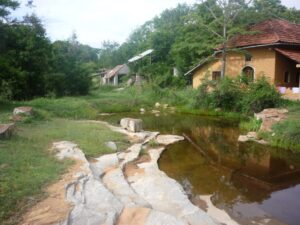
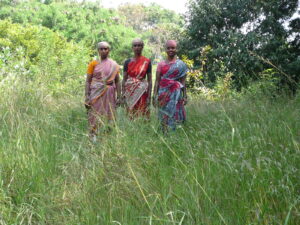
Navadarshanam has also helped create and continues to guide the activities of a food initiative operated by the local villager community that offers organic, wholesome food choices to urban consumers while supporting rural livelihoods and preserving traditional skills and farming ecosystems.
Within a span of 30 years, the lands at Navadarshanam have gone through some remarkable transformations. What was a barren, over-grazed, eroded and degraded 100-acre parcel, was protected to prevent large-scale cattle grazing. Additionally, earthworks were constructed on the land to slow down the water flow, hydrate it, prevent erosion and allow for a natural process of recovery and regeneration to take place.
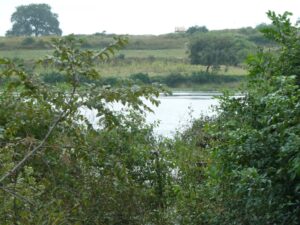
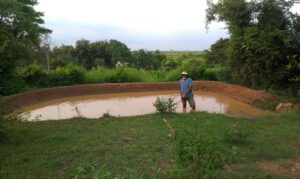
In 8 years, a scrub jungle had emerged and a small herd of cattle of about 30, were reintroduced to keep some of the dry grass cover down to reduce the dangers of grass fires. The land immediately regressed and so the grazing of cattle was completely stopped. Since then, in the last two decades, the land has completely recovered into a diverse forest comprising of grasses, shrubs, and short and tall trees and is supporting over a hundred species of birds, a number of small animals and even a few months stayover for the Gaur, small herds of elephants and frequent visits by leopards.
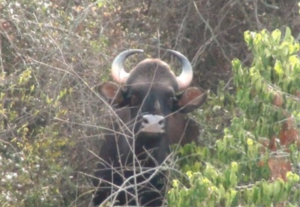
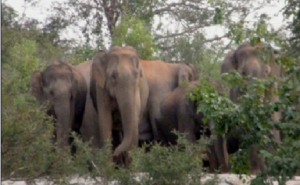
Natural regeneration has inspired most of the other activities, most importantly, farming practices. The farming practices at Navadarshanam combine traditional knowledge systems relating to field crops and rain-fed farming with agro-forestry, permaculture and natural farming principles to achieve low till, low input, low intervention farming methods. Over the years, yields have increased vastly while at the same time, these farming practices have enriched the soil with each cropping cycle and enlivened the broader ecosystem.
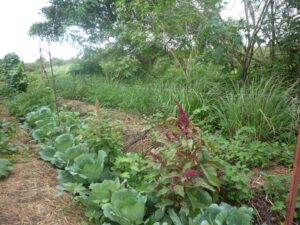
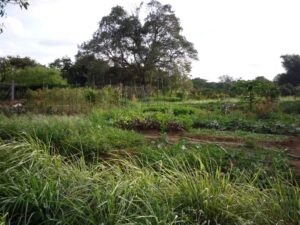
Bordering the community on one side is what used to be the Thalli Reserve Forest (TRF) which has recently been upgraded and combined with a broader forest under the banner of the Cauvery Wildlife Sanctuary providing protection among others to elephants. The first decade at Navadarshanam saw a rapid degradation of TRF due to a daily harvest of forest products for livelihoods by the villagers living around the forest. The area receives medium to low rainfall, has one rain-fed crop (millets and pulses) and the marginal farming community was subsisting on other sources of income including that from forest products. The expansion of Bangalore city and the opportunities for trades (masons, carpenters, electricians, gardeners etc.) in rural Bangalore districts has, ironically, reduced the pressure on forest-based income as many of the villagers adapted to the changing situation.
For the village of Ganganahalli, Navadarshanam’s food cooperative provided an alternate sustained livelihood from value-added organic food processing and helped 30 families get out of their dependence on forest products and related activities for sustenance.
Ideas on a localised approach to ecological restoration
This is an attempt to articulate some ideas on an approach to ecological restoration and to scale it up to make a meaningful impact on the climate while ensuring enduring participation by local communities of people. Perhaps there needs to be a people-participatory framework that creates mandates for local communities all over the planet to achieve specific ecosystem goals with measurable metrics for progress. Ecological activity must be incepted into the ethos of communities across the globe as one of the highest moral-social values since our survival is going to depend on it.
Having stated this, it would be profoundly incomplete to look at the physical realm alone. Deep inner reflections that make the ultimate connections with the ever-living presence within help develop inner strength and resilience to navigate this planetary crisis. Our thoughts and actions need to emanate from this space that remains untouched by this crisis.
Guiding principles
- Push for global community-level participatory models: Given the urgency of the climate crisis, there is a need to act quickly and on a global scale – but this must take the form of uniquely designed local initiatives. The enduring effort that is needed will require that every member of every community be taken along in the participatory model.
- Implement regenerative and self-regulating systems: There needs to be a shift away from ultra-interventionist models and instead towards creating systems built on natural principles that, over time, ensure dynamic stability and require less frequent interventions.
- Seek localised solutions and implementation strategies: While the core ideas may be derived from a common set of principles, solutions need to be designed to meet local needs and strategies.
- Make water a key part of the solutions – ‘planting the rain’: Central to any eco-restorative work is the precious resource of water. The idea of ‘planting the rain’ is to ensure that rainfall overflow is captured or slowed down, managed and as needed percolated through earthworks into the ground to passively irrigate landscapes and recharge groundwater. Such a system typically involves the creation of lakes, swales, ponds, simple berms and basins to capture and passively hydrate the landscape thus providing a toe-hold for natural vegetation.
- Ensure protection of ‘the skin of the earth’: The living soil comprising a thin layer of organic matter on the surface of the earth acts as the nutrient factory and is fundamental to any eco-restorative work. The living soil mediates the natural cycles that ensure that what is taken from the atmosphere is returned to it and what is taken from the soil is returned to it. Ensuring that land management and agricultural activities protect and enrich the living soil is vital for continued human survival.Overall, perhaps there needs to be a ratification of the approach in the form of a UN Climate Change Ecological Restoration (UNCCER) initiative stamp that can then be used to designate all sites under its ambit (like how a designated UNESCO site receives protection and funding).
Ecosystems and restorative work
The types of issues, the communities involved, and the potential nature of the solutions and engagement are different across different ecosystems. We will therefore look at the implications for each of the following different ecosystems:
Forests
These include protected sanctuaries, reserve forests, unprotected forests, buffer zones, and private wooded areas. What is needed here are protective mechanisms to preserve what exists from degrading further by harvesting rain and improving local hydrology, restoration of local biodiversity, and bringing livestock densities to a level that can be supported sustainably. One of the biggest challenges in these types of ecosystems is the pressure from human activities in terms of resource extraction, animal grazing and human-induced forest fires that often cause vast devastation. There is also a lack of public-private partnerships to secure funding and an absence of coordinated effort or will to secure and protect vast tracks of land.
Some ideas that can be considered for restorative work in forest lands are:
- Identification and designation of forests as UNCCER-protected-forests
- Identification of local funding sources for each forest – corporate social responsibility (CSR) initiatives and other private endowments
- Identification of local partners (government, NGOs, others) for specific solutions and implementation strategies and, most importantly, establishing local community participatory model for stewardship of lands and resources
- Practice of regenerative animal grazing: Designation of multiple pastoral patches at the edge of forests for grazing and rotation of grazing to ensure that the forest itself is protected from grazing and related destructive forces
- Where possible, identification of alternative livelihood options to compensate for the loss of income due to the reduced scale of animal farming
- Creation of swales, ponds, simple berms and basins to capture and passively hydrate the landscape providing a toe-hold for natural vegetation
- Creation of niches for the restoration of biodiversity. Implementation of active interventions where required by the reintroduction of local biodiversity, elimination of invasive species and eventually, the triggering of automatic regenerative growth
Wild grasslands and scrublands
These include open grasslands and land with shrubby terrains mostly belonging to the government. What is needed most here is the modification of land use policies to ensure these lands and the enclosed wilderness are afforded the protections needed. Once this is done, other steps to improve local hydrology and biodiversity can be taken up along with bringing livestock densities to a level that can be supported sustainably on the land. The biggest issue here is the lack of proper zoning resulting in the fragmentation of lands. There are factories, office spaces, farmland, wooded areas and human settlements all mixed in making it hard to delineate ecological responsibility. The other challenge in these types of land is the destruction caused by human-induced fires and over-grazing.
Some of the key priorities for restorative work in wild grasslands are:
- Policy-level intervention by the government to create and enforce clear zoning and land use policies
- Identification, designation and protection of grasslands as UNCCER-protected grassland ecosystems
- Identification, designation and management of grazing pastures with local community partnership – this is key to reducing the impact on livelihoods while ensuring local support and participation
- Building stewardship within the local community by acknowledging ecology as a high moral-social value in traditional communities and providing local community-level incentives
- Protection of existing water bodies and creation of new ones
Farmlands
These ecosystems are for the cultivation of crops – based on water use, these are irrigated or rain-fed farmlands and based on the type of crops and practices these could be field crops, horticultural crops, cash crops, plantations or for animal farming. Farming ecosystems, by virtue of being directly and intrinsically linked to food security and the survival of human populations across the globe, have practices that are driven by the industry, are deeply entrenched and also come within the ambit of government policies and subsidy regimens.
Some of the key changes that need to occur here are:
- The need to develop a deeper understanding among farmers, consumers, government and industry of sustainable farming practices and the realisation of their enormous potential to address food security and climate change at the same time
- A methodical transition to sustainable farming practices – the scope of these practices needs to include localisation of water sources for farming, protection and revival of the mineral richness of soil through practices that ensure natural restorative and recovery cycles, and finally, localisation of seeds and seed sovereignty
- A revised approach to food processing and distribution systems, as well as policies that guide food security, nutrition and health.
The biggest challenge here is that governments, industry and academia, for various reasons, have not embraced sustainable farming practices. Much of the scientific research and technologies released into the mainstream simply do not appreciate the interconnectedness of things, especially in living systems and the self-regulatory mechanisms that exist in nature. Businesses and industry are simply not motivated to promote sustainable farming since it would essentially decimate agribusinesses involved in chemical fertilizers, pesticides and seeds. In the absence of scientific initiative and industry backing, governments which are tasked by the people with ensuring food security and health for all, continue to remain in fear, uncertainty and doubt with respect to implementing sustainable practices. The lack of systematic data on large-scale sustainable farming models also contributes to this fear. Another challenge is the loss of prime farmlands to non-farming uses at a rapid pace.
Given all of the above, some of the key priorities for restorative work on farmlands include dramatic shifts in education, government policies and farming practices. These are:
- Shifting the emphasis in course content and research in educational institutions to sustainable farming practices, appropriate technology, study and capture of methodical data globally from sustainable farming initiatives
- Establishment of a framework for educational institutions to partner with local NGOs and government to create a sustainable food security plan that guides the rework of localised farming practices, distribution systems and consumer education
- Re-education of consumers regarding the absolutely essential need to make changes in food choices. (The current conventional food growing, processing and consumption practices are predominantly unsustainable and unhealthy.)
- Policy-level changes to gradually phase out subsidies to non-sustainable farming models
- Policy-level intervention by the government to create and enforce clear zoning laws and protect farmlands
- Establishment of a food tax penalty for consumers that is based on the ecological footprint of food, that is, factor in aspects such as food miles, non-seasonality, animal products, water use etc.
- Creation of a timeline for the adoption of sustainable farming practices making it illegal to continue (for example, stubble burning, non-native crops) beyond a point
- Government support for the re-establishment of community-level seed banks with a local farmer participatory model
- Protection of existing water bodies, creation of new water bodies, implementation of passive irrigation systems, and active irrigation using efficient low water use systems
Semi-urban
These ecosystems are typically patches of farms, green spaces and water bodies interspersed with buildings and other human infrastructure. These are the emergent ecosystems in developing countries as cities expand out into rural districts encircling farmlands or as villages grow into small towns and cities and transform farming lands and rural communities. There is an urgent need to formulate and enforce proper zoning laws, protect existing water bodies and create new ones, protect existing green spaces and create new ones and finally protect existing farmlands and incentivise local food production.
One of the big challenges here is that the conventional ideas of town planning and administration simply do not address some of these issues. Administrators and policymakers do not have a framework to guide policies towards creating sustainable human habitation. Unfortunately, these ecosystems are perhaps the fastest growing, experiencing rapid change and require immediate and active interventions to prevent spaces from quickly transforming into semi-urban sprawls.
Some priorities for climate-change-related restorative actions in semi-urban landscapes are:
- Policy-level intervention by the government for the creation and enforcement of clear zoning and land use policies that protect existing green spaces and farmlands
- Issuance of new buildings and other infrastructure permits needs to factor in the protection of green spaces and potential mandates to maintain appropriate ratios of green spaces
- Incentives for the growing and distribution of food locally
- Development of localised strategies for re-greening and reforesting small open parcels of public lands, for example, creating stepping-stones forests
- Mandate localised rainwater harvesting (RWH) for storage and recharge of groundwater
- Mandate localised grey water and sewage treatment for landscape use
- Implementation of reforms in the content of academic course work and training, for example, architecture and town planning, civil and construction engineering disciplines
Urban
These ecosystems comprise dense human infrastructure with small public parks, green spaces, private gardens and water bodies. The future of urban ecosystems depends on their ability to implement restorative practices and adapt to climate change. The challenges faced in these ecosystems are multifaceted – high energy needs to combat the heat island effects, water issues, loss of green cover and biodiversity, high food miles and overburdened infrastructure for managing grey and black water. Apart from this, urban landscapes as population centres expressing consumer demand and as hubs of economic activity exert an enormous influence over all the other ecosystems. To that extent, the policies and practices adopted in urban landscapes trickle down to rural landscapes.The biggest challenge with urban ecosystems is the complex and almost chaotic evolution of most of these spaces making it difficult to rework infrastructure and make core changes in strategies.
Some of the key priorities for urban ecosystems include:
- Protection of any remaining open spaces and designation for the creation of green spaces and urban forests
- Utilisation of the commons (open lots, sidewalks, traffic islands, public parks) and other open spaces (rooftops, parking lots, private gardens) to plant and promote local biodiversity and food plants and trees
- Protection of existing water bodies, creation of new ones and implementation of policies with a view to localising water sources
- Implementation of RWH for storage of water from structural runoff and percolation into the ground of runoff from the other surfaces and roadways with proper management of overflows to prevent flooding. Water planted in the good rain years needs to support the ecosystems through the bad rain years
- Local sustainable food systems and the creation of infrastructure for local food markets all in urban spaces – levy of ecological tax for non-local food
- Planning for a decentralised, localised handling of sewage and grey water, recognising these as valuable perennial water and nutrient sources
- Creation of public-private-NGO partnerships to implement the policies; mandate people’s participation in the bio-diversity development of urban spaces
Note: Other important ecosystems like freshwater (rivers, lakes and riverine ecosystems) oceans and coastal ecology have not been discussed in this article.
AUTHOR
Gopi Sankarasubramani is a farmer and resident trustee at Navadarshanam. An aerospace engineer from IIT, Gopi was a technologist based in California for over 20 years. While living in California, he left the technology industry to explore his lifelong passion for growing food while leading a simple life. He worked on farms in the US and formally studied permaculture and sustainable farming practices.


A wonderful indepth report and a success story about the sustainable practices followed to recreate a barren space….and what needs to be done in the future to reduce the carbon footprint …
Amazing vision and a focussed journey to reach the goal. The icing on the travel is the inclination and enthusiasm to spread the awareness… and provide livelihood and disperse the seeds of knowledge to all… Finally the inner work, peace and calmness which has made the project a remarkable one… Best Wishes..